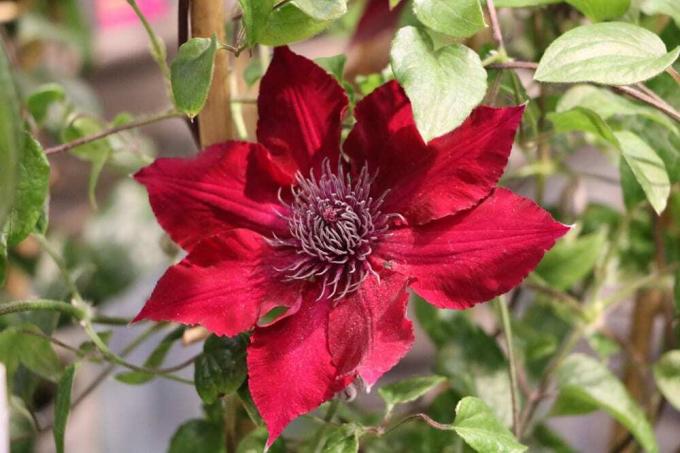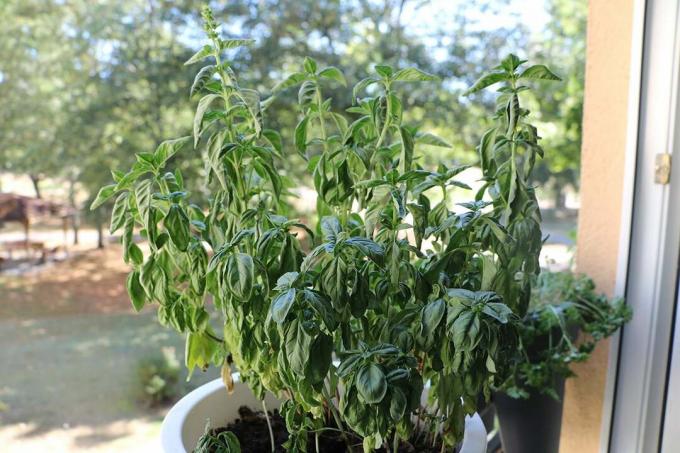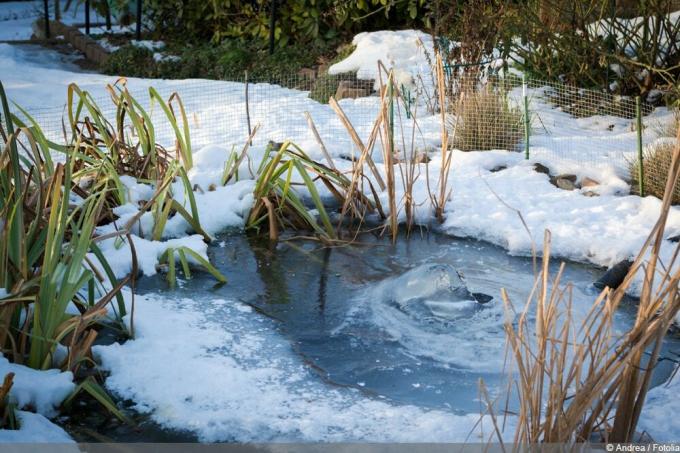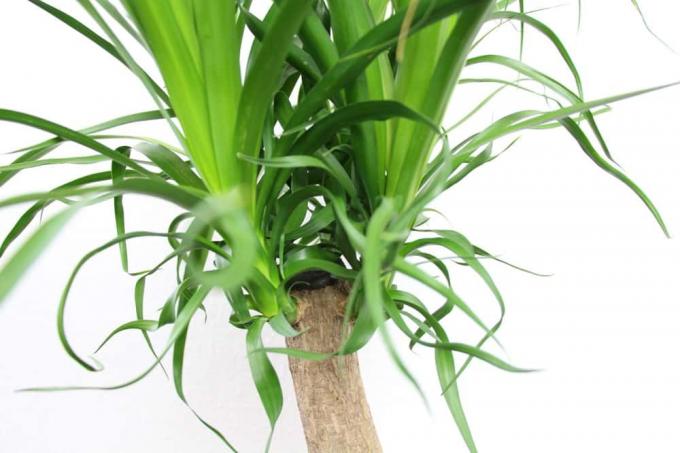

Table of contents
- They are all perennial - not always hardy
- Overwintering frost-sensitive clematis – this is how it works
- Hardy species are vulnerable in the bucket
- Protect frost-resistant climbing shrubs in the year of planting
- Perennial clematis have a special status
- These varieties are extra hardy
- Blue Princess (Clematis alpina)
- The President (clematis hybrid)
- Blue Angel (Clematis viticella)
- Odorata (Clematis montana)
- Baby Blue - Perennial Clematis (Clematis integrifolia)
- Conclusion
Among the more than 300 species of clematis found worldwide, there are deciduous and evergreen climbing shrubs as well as lavishly flowering, herbaceous perennials. In view of this variety, it is obvious that the question of winter hardiness cannot be answered with a short yes or no. A differentiated approach brings light into the darkness and ensures that your clematis does not stop at a short interlude in the garden and on the balcony. The following instructions describe in a compact and understandable way how to overwinter a clematis in a way that is appropriate to the species.
They are all perennial - not always hardy
Clematis are among the cosmopolitans in the plant kingdom. They can be found in the wild in almost every region of the world, preferring wooded mountains, which is where their middle name clematis comes from. They mostly thrive as deciduous climbers that use their twisting leaf stalks to climb trees. A few clematis have chosen tropical and subtropical climates as their home, where they wear their foliage all year round thanks to the mild temperatures.
Clematis has the potential for a long life in its respective distribution area. Under ideal conditions, the climbing artists reach an age between 20 and 70 years. The European and Asian species succeed in this because they have good winter hardiness. In contrast, evergreen clematis do not know frost, so they are not hardy, regardless of their multi-year growth. The following overview of the most popular types for the ornamental garden provides information about the differentiated winter hardiness:
- True/common clematis (Clematis vitalba): hardy to -37 degrees Celsius
- Italian clematis (Clematis viticella): hardy to -25 degrees Celsius
- Alpine clematis (Clematis alpina): hardy to – 25 degrees Celsius
- Clematis (Clematis integrifolia, Clematis recta): hardy to – 25 degrees Celsius
- Clematis (Clematis montana): hardy to – 20 degrees Celsius
- Japanese clematis (Clematis florida): hardy to -12 degrees Celsius
- Chinese, semi-evergreen clematis (Clematis kweichowensi): hardy to -12 degrees Celsius
- Chinese, evergreen clematis (Clematis armandii): hardy to - 6 degrees Celsius
- Australian, evergreen clematis (Clematis microphylla): not hardy: temperature minimum 5 degrees Celsius
While concrete statements can be made about the hardiness of pure species, this does not apply to the opulent hybrids. After all, conclusions can be drawn on the extent to which a hybrid is cold-resistant based on the parent plants. The world-famous clematis 'Rubens' comes from Clematis montana and has a similarly good winter hardiness. The Italian clematis was the inspiration for numerous Jackmanii hybrids, which stand out with particularly large flowers and are just as frost-tolerant as the pure species.
Overwintering frost-sensitive clematis – this is how it works

The hibernation of evergreen, semi-evergreen and other conditionally hardy clematis is rarely successful in the open air, so cultivation in a bucket is recommended. The corresponding species and all hybrids that have emerged from them will only give you growth for several years if you can spend the cold season behind glass. How to hibernate:
- Admit from a night-time minimum of 5 degrees Celsius
- The winter quarters are light and frost-free at 5 to 15 degrees Celsius
- Do not fertilize from September to March
- Water less so the root ball doesn't dry out
Is your garden located in a wine-growing region with mild winters or does it have an adequate microclimate? Then there is a good chance that the early flowering, evergreen Clematis armandii can be planted out. Nevertheless, winter protection should not be dispensed with. Covering the root disc with leaves and twigs keeps frost and snow at bay. In the first 2 to 3 years, a reed mat protects the shoots from icy winds.
Hardy species are vulnerable in the bucket
Information on winter hardiness relates exclusively to clematis in the bed. Deep in the ground, the root ball is so well protected that it survives severe frost. The local site conditions and professional planting also play a part in this approach. This does not apply to potted plants, since the root ball is in a vulnerable position here. The comparatively small substrate volume and the thin vessel walls do not provide sufficient protection against frost. With the following precautions, frost-resistant Clematis species can still overwinter outside in the bucket:
- Cover the pot with several layers of foil before the onset of winter
- To protect against frost from below, place the bucket on a block of wood
- Cover the substrate with autumn leaves, wood shavings or bark mulch
In wind-exposed locations, you also surround the bucket with a coconut or reed mat that protrudes the edge of the bucket by about 10 cm. A location in front of the south wall of the house or in a rain and wind-protected garden niche is advantageous.
Tip:
A low-competition underplanting provides a shady base in summer and serves as a buffer zone against frost in winter. Small ornamental grasses and ferns fulfill this task perfectly as useful foot soldiers for the royal clematis. The Japanese mountain grass (Hakonechloa macra), the dainty forest grove ledge (Luzula sylvatica) or the small Himalayan venus hair fern (Adiantum venustum) are excellent candidates for these Function.
Protect frost-resistant climbing shrubs in the year of planting
If your clematis is neither a cold-sensitive nor a potted plant, you still cannot avoid winter protection. At least in the year of planting, the climbing queen cannot do without these supporting measures against severe frost:
- In late autumn, pile up the bed soil with leaves and needle brushwood
- Stick brushwood around the young shoots as a windbreak
- Do not apply fertilizer from September
- Water occasionally in winter when there is a frost so that the rootstock does not dry out
If a hardy clematis species survived its first winter healthy with this protection, it will have a stable frost resistance of its own in the following years. Should the plant take the toll of severe frosts and freeze back, don't worry. In the spring, cut back the dead shoots into the healthy wood. The clematis will sprout again from a vital rootstock.
Tip:
Professional planting contributes significantly to the successful overwintering of a garden clematis. Choose a sunny to semi-shady location to plant the young clematis so deep that the root neck is about 10 cm covered with soil.
Perennial clematis have a special status

Perennial clematis are the survivors within the multi-faceted clematis genus. The herbaceous plants thrive in almost any location and inspire with beautiful flower and leaf shapes. Since they have no climbing organs, the shoots are directed in the desired direction with the help of climbing aids. However, some species form such strong stalks that they can do without a support. All perennial clematis are reliably frost-resistant. The herbaceous shoots retract completely in winter, only to sprout again punctually in spring. In order to overwinter herbaceous clematis species properly, a strong pruning is integrated into the care program. How to do it professionally:
- In November or December, cut back all shoots to 10 or 20 cm above the ground
- In the year of planting, cover the root disk with a layer of leaves and fir fronds
- Equip the bucket with a winter coat made of foil, jute or fleece every year
In early spring, when the mercury column rises above freezing, winter protection can be removed. In order to protect the young shoots and buds from delayed ground frosts, a light and breathable fleece should be at hand by the end of May. If the weather report announces frost at night, a simple hood will protect a perennial clematis from frostbite.
These varieties are extra hardy

Consult this guide to wintering before acquiring a clematis? Then shortlist one of the following hand-picked species and varieties that have proven to be particularly frost-resistant in practice:
Blue Princess (Clematis alpina)
The early flowering alpine clematis is native to Germany, so it has a stable frost hardiness down to - 25 degrees Celsius. The royal beauty of the flowers also scores with two flowering times, impressive vigour, and a healthy constitution. Its light blue flowers with a white center grow to 5 cm and appear in such large flocks that they almost cover the light green leaves.
- Flowering period: April to May and September
- Growth height: 220 to 320 cm
The President (clematis hybrid)
There is no getting around these premium strains. Where The President resides, facades and fences are transformed into a furious sea of flowers. Each individual flower shines in crimson and boasts a diameter of at least 10 cm. One of the numerous advantages of this proven clematis hybrid is its unconditional winter hardiness down to -25 degrees Celsius.
- Flowering period: May to September
- Growth height: 180 to 400 cm
Blue Angel (Clematis viticella)
With an Italian temperament and light blue, ruffled flowers, this clematis has won a large following among home gardeners. Its popularity is also based on robust health and fail-safe winter hardiness down to -25 degrees Celsius.
- Flowering period: June to October
- Growth height: 200 to 400 cm
Odorata (Clematis montana)
Lavish abundance of flowers, impressive growth and a winter hardiness down to -20 degrees Celsius characterize this top-class mountain clematis. When it comes to greening large facades, the light pink flowering Odorata should be at the top of the wish list. The cross-shaped petals frame a sunny yellow center and exude a seductive vanilla scent.
- Flowering period: May and June
- Growth height: 400 to 1200 cm
Baby Blue - Perennial Clematis (Clematis integrifolia)
It inspires with blue bell-shaped flowers, two flowering periods and decorative fruit decorations in autumn. In winter, the perennial clematis withdraws into its rootstock, which easily endures freezing temperatures down to -25 degrees Celsius. When the first rays of sunshine warm the ground in spring, the young shoots busily sprout to repeat their blossom festival.
- Flowering period: May to June and September
- Growth height: 30 to 40 cm
Conclusion
Clematis thrive all over the world as perennial climbing plants with fabulous abundance of flowers. Although a clematis can reach an age of up to 70 years, it is not always accompanied by reliable frost resistance. At least tropical evergreen clematis haven't learned to survive in winter conditions. Therefore, they should be cultivated in tubs and overwintered behind glass. The vast majority of European and Asian clematis species are so hardy that light winter protection only makes sense in the year of planting and in the tub. As these instructions for overwintering explain in detail, simple precautions are enough to safely escort the queen of climbing plants through the cold season.
 garden editorial
garden editorial I write about everything that interests me in my garden.
Learn more about overwintering plants

How much frost do horned violets tolerate?
Horned violets are a popular bedding plant that survives the winter. They are planted either in spring or in autumn and overwinter in the beds. They usually do without frost protection, which is why they are also often used as easy-care plants for graves.

Is the dragon tree hardy? 7 tips for wintering
Dracaena, the botanical name of the dragon tree, is not just coincidentally reminiscent of a palm tree. Like the palm trees, it also likes it warm and sunny. He is not hardy and has to hibernate in the house. Here are some tips.

Are asters hardy? 5 tips for wintering
The summer aster and the autumn aster not only differ in their flowering time. When winter arrives, another difference becomes apparent: one dies, the other survives the frost.

Overwintering basil: 7 tips for caring for it in winter
If you want to enjoy fresh basil in winter, you can overwinter it with a little skill. With these 7 tips you will definitely succeed!

Overwintering pond plants | Aquatic plants in winter
The garden pond is an important design element in the garden for many hobby gardeners. With the right pond plants, it draws everyone's attention. The numerous species differ in their appearance, their planting location on or in the pond and, last but not least, their winter hardiness.

Overwintering Yucca Palm - Is It Hardy?
Although yucca palms are indoor plants, they like to be outdoors in the summer. However, most species are not hardy. It is necessary to winter them indoors. You can find out how to do this here.



